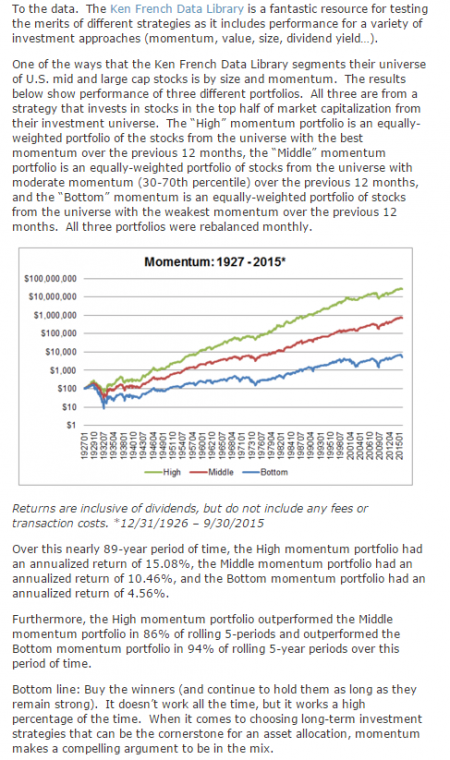
Buy the Winners
Eugene Fama, Father of the Efficient Market Hypothesis (EMH), has referred to momentum as "the premier market anomaly" which represents "the biggest embarrassment for Efficient Market Theory". And it's also very simple. So simple that it's under appreciated.

Source: http://systematicrelativestrength.com/2015/10/26/buy-winners-2/
I'm going to paraphrase about a five minute clip of the podcast which can be heard here. I highly recommend it.
The podcast
Covel: Losses are statistically inevitable. There are still a number of people out there, some astute and some not, that still don’t want to imagine losses as a part of the game.
Kirk: Yep, people are desperate to invest in something that never loses money. And that, of course, is why Bernard Madoff existed. Everyone is desperate to invest in something that never loses money. I’d like to invest in something which never loses money. I’d love to come up with a strategy that never loses money. Of course, we all want that.
The reality is that maybe the best you can look for over a long period such as 20 or 30 years is a Sharpe ratio of .8, .9, maybe 1.
Take a simulation of a 20% volatility with a 20% return per year. Every 2 years you will have a drawdown of 15% statistically, and a 20% drawdown every 4 years. And you don’t have to run very many simulations before you get a 40% drawdown that can last five years. Remember, this (simulation) is something that is guaranteed to make 20% per annum over a long enough period of time. The expectation of losses should be something everyone should build into their investment process at all times.
Summary
The enemy of a good plan is the dream of a perfect plan. Drawdowns and losses are part of the game but your human nature of survival will put up a fight against rationality when drawdowns occur. The human brain is capable of incredible optimism as well as pessimism. Be aware of it, and have expectations that are statistically valid. Not just past performance.
Jesse Blom is a licensed investment advisor and Vice President of Lorintine Capital, LP. He provides investment advice to clients all over the United States and around the world. Jesse has been in financial services since 2008 achieving multiple industry achievements including qualifying membership in the Million Dollar Round Table for 5 consecutive years. Membership in this prestigious group represents the top 1% of financial professionals in the world. Jesse has a Bachelor of Science in Finance from Oral Roberts University.
Jesse is managing the LC Diversified portfolio.




Join the conversation
You can post now and register later. If you have an account, sign in now to post with your account.
Note: Your post will require moderator approval before it will be visible.